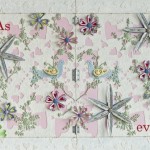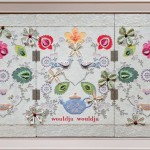Born Detroit / BFA, School of the Art Institute of Chicago; MLS University of Detroit / Lives in Detroit
“perchance,” “we two,” “yesterdays,” and “wouldja wouldja” are a few of the words that embellish and echo across Patrick Burton’s richly ornate paintings. Their plaintive and conditional overtones urge a viewer—albeit in low key, lower case font—to wonder: “perchance” what? “we two” who? “wouldja wouldja” do what? Nestled here and there (center top or bottom, lower or upper right) and incised or raised slightly above the surface, these messages are of a piece with the soft, silvery pastels and three dimensional blossoms, hearts, leaves, fronds, and vines that proliferate across Burton’s low relief compositions.
In fact, the inscriptions—or poesies, as Burton refers to them, after the 15th century practice of gifting a lover with a “posy ring” etched with a word or two suggestive of love—are the enigmatic starting points for his images, to which the artist also appends longish literary titles: “perchance,” for example, is formally titled For A Time The Story Must Go Back Somewhat And Tell All That Had Chanced The First Night We Met (2007); and “As ever,” writ on another composition, becomes As Ever, I Give You Me (2003). This literary flair is attributable in large measure to Burton’s omnivorous reading regimen from an early age (Gertrude Stein, Langston Hughes, Jean Genet, Carl Van Vechten); his studies at UD toward the Master of Liberal Studies degree and subsequent years of teaching both English and Fine Arts in Detroit Public Schools until recently; and his fifteen year foray into scripting and producing performances—among them Love Tales and Broken Hearts, “Beauty,” “Until,” “Punk”—throughout the 1990s. By the end of the decade, as he yearned for a format with longevity and permanence, painting beckoned as an alternative to theater.
When Burton returned to painting in 1999 with Thrice Told Tales, a triptych, he developed his fastidious, detail-oriented technique of measuring and laying out the composition to the millimeter; cutting, painting and beading wood or papier-mache forms; and finally, layering and gluing down the numerous, delicate elements that furnish a completed work. The free-form patterning in this original effort gives way to tightly patterned, symmetrically organized arrangements, as in I’ll Keep Your Kiss With Mine (2014). Yet, at the same time as structural elements—stems, trunks, branches—anchor compositions, the balanced but irregular placement of birds, blossoms, hearts, or four leaf clovers relieves the rigid precision of the underlying grid. Valentine hearts also proliferate in numerous works, as many positioned upside down as right side up, to imply, as Burton notes, the perils that accompany a lived life.
A perhaps surprisingly prosaic element in Burton’s rarefied world are the generic, silver toned hinges that link together the panels of dip- and triptychs to highlight pairing and partnering of individuals. (Many bear dedications to Burton’s “chosen family” members.) The hinges are emphatically nonfunctional, however, and the abutting panels are locked within their artist-designed frames. Yet these multi-panel formats allude as well to portable, domestically scaled, memory-laden objects (screens, altarpieces, picture frames) that, when moved from place to place, live on again in their new setting. Indeed, one might belatedly realize that beyond the dazzling, decorative elements that seize the eye and lure one in, the titles address the often intimate relationship between artist and observer: As Ever, I Give You Me; The Real Patrick Burton Story As Told By Zora Neale Hurston And Carl Van Vechten (2005); He Loves You, So (2003).
Other stately, large scale, recent works, such as My Life Lies Elsewhere (2013), with “I love you” adorning its surface, posit a firm, declarative assertion, heralded by both image and inscription. The sturdy, anthropomorphic trio of vases, with tall, rising stems and “heart-heads,” visited by doves of peace and bluebirds of happiness, all aglitter with Swarovski crystal beads, mark a singular moment in Burton’s oeuvre. The romantic declaration is counterpointed, however, by its pragmatically nuanced title, frankly intimating that really and truly—but out of sight and handwritten on the back of the support—life lies elsewhere. For, much as he might love his progeny (and this one entailed a year from gestation to completion), an artist invariably harbors a longing to move on.
Dennis Alan Nawrocki, November 2015
Copyright Essay’d 2015








